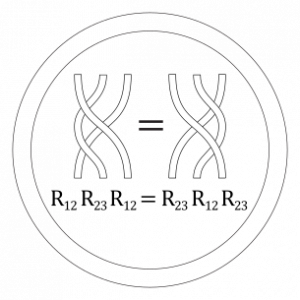Yang-Baxter equation
Yang Chen-Ning (b. 1922) and Rodney Baxter (b. 1940)
Yang-Baxter equation 1968 and 1971 respectively
In physics, the Yang–Baxter equation (or star–triangle relation) is a consistency equation which was first introduced in the field of statistical mechanics. It depends on the idea that in some scattering situations, particles may preserve their momentum while changing their quantum internal states. It states that a matrix {\displaystyle R}R, acting on two out of three objects, satisfies
- $${ ({\check {R}}\otimes \mathbf {1} )(\mathbf {1} \otimes {\check {R}})({\check {R}}\otimes \mathbf {1} )=(\mathbf {1} \otimes {\check {R}})({\check {R}}\otimes \mathbf {1} )(\mathbf {1} \otimes {\check {R}})}$$
In one dimensional quantum systems, $${R}$$ is the scattering matrix and if it satisfies the Yang–Baxter equation then the system is integrable. The Yang–Baxter equation also shows up when discussing knot theory and the braid groups where $${R}$$ corresponds to swapping two strands. Since one can swap three strands two different ways, the Yang–Baxter equation enforces that both paths are the same.

